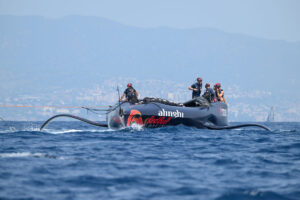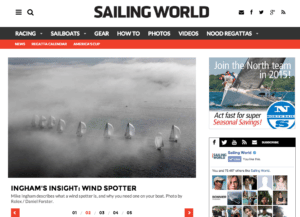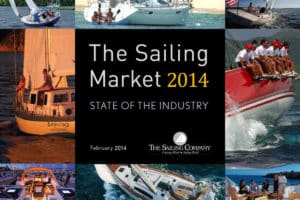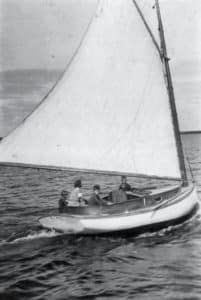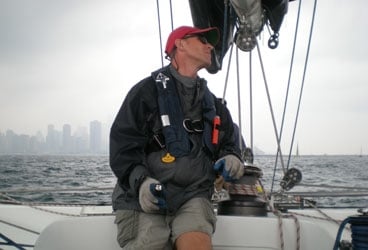
HWChicagoMac368
Quite literally, I got my first taste of the difference between ocean racing on the briny blue and Great Lakes racing on a freshwater sea several hours prior to the July 19th start of the 100th edition of the classic Chicago-Mac Race. For that’s when, quite by accident, a fellow crewmember aboard Todd and Ryan Howe’s Open 60 trimaran Earth Voyager flicked my cell phone into the drink. The ensuing plunge into Lake Michigan’s cool, clear water to retrieve the damn thing was, well, bracing, but the post-swim revelation was equally eye opening. I wasn’t salty, sticky, scratchy, or clammy. Now that, I thought, was something I could get used to.
It was the first in a series of ongoing revelations that lasted the length of the roughly 300-nautical-mile racecourse, from the bustling, downtown shores of the Second City to the remote island enclave of Mackinac (the last syllable is pronounced “naw”). Time and again, for the duration of the race’s historical milestone, the Mac just kept offering one surprise after the next.
As I’ll be writing a story for the print edition of Sailing World on the specifics of sailing Earth Voyager and what transpired in the multihull fleets, for this report I’ll forgo delving into much detail on that aspect of the race. I will say that, in the fleet of some 430 boats, Earth Voyager was third to finish overall–behind the Turbo Section maxis Genuine Risk and Windquest–and that the Howe lads were more than a tad disappointed not to have nabbed line honors. Their wing-masted tri needed breeze, in abundance, to keep in front of the big monohulls, but the fickle winds that ruled the lake during the race simply didn’t provide the horsepower.
But that led me to the second of my surprises: You’d better be on top of your light-air game, with the requisite quiver of sails, if you want to do well on your average Mac race. Almost twenty years ago, I did my only other Mac race, aboard a 45-footer, and we thrashed to weather in cold, northerly headwinds and short, rude seas the entire distance, just a miserable experience. I thought it was like that every year.
Not so. In fact, several days after the Saturday afternoon start, a steady stream of yachts continued to trickle under the Mackinac Bridge, three short miles from the finish line, painted boats upon placid waters. And as to whether any of the competitors in the massive Tartan 10 fleet would ever finish, that matter remained squarely in doubt. More than one Old Goat–we’ll get to them in a moment–told horror stories of endless, frustrating Mac races in which they failed to arrive until well after the beer was gone, the parties over, and many of the winners had long ago split. Actually, there were a lot of those stories.
That brings us to the Old Goat Sailing Society, a membership so revered that their ranks are listed in a two-page spread at the very forefront of the 80-page Scratch Book and Sailing Instructions (yes, 80 pages…it was a colossal fleet). To become an Old Goat, one needs to compete in 25 Mac Races, which breaks down to an estimated 60 days at sea, 50-100 thunderstorms, or 250 watch changes. The man currently at the top of the list, John Nedeau, Sr., has contested the Mac sixty times. Yes, sixty. The Old Goat aura permeates the event. There are retired Old Goats, active Old Goats, and youngish-type Goats-in-Waiting who only need three or four more Macs before earning their Old card. You run into these guys everywhere, they’re the very fabric of the proceedings. Now every offshore race has its veterans and regulars, guys who turn up year after year. But nowhere are they respected and honored as they are at the Mac. It’s cool.
So, too, is the racecourse itself, a straightforward shot up the lake until the latter stages, through or around the stunning Manitou Islands; inshore against the tall, dramatic, white-sand bluffs; and finally up Mackinac Strait and beneath the long arch of the Mackinac Bridge. The island itself is a beautiful, historic resort closed to automobiles where horse buggies ply the main thoroughfare and there are endless opportunities for chow and libation. It’s a fun place to wind up after few days at sea, and there are few grander venues for an awards party than on the spacious lawn of the Grand Hotel.
When all’s said and done, however, the success (or otherwise) of any regatta will ultimately fall upon the sailors themselves. And my final impression of this year’s Chicago-Mac is that the event sure attracts a high level of enthusiastic and skilled competitors, who not surprisingly just happen to be solid, fun-loving folks, as well. For a jaded easterner like myself, there’s something very grounding and reassuring about mid-western hospitality.
Yes, this year’s centennial affair attracted huge record-setting numbers, so I may have been on hand for something unusual, but somehow I don’t think so. The Mac is an enduring phenomenon, a special race that’s as much a slice of Chicago as deep-dish pizza, Wrigley Field, Rush Street, and da’ Bears. If you’re a sailor who’s never been, do yourself a favor. Get to the next one.

